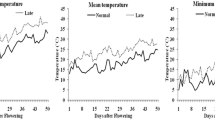Abstract
Heat tolerance in 45 chickpea, lentil, and faba bean genotypes was investigated during 2007/2008 and 2008/2009 at Alexandria Agriculture Research Station, Alexandria, Egypt, using screening methods employing the membrane thermostability technique. Threshold temperature to be used in screening for heat tolerance at germination was also investigated for each crop. Temperatures, responsible for 50% germination were 40, 33.5, and 29°C for chickpea, faba bean, and lentil, respectively. Germination percent under high temperature varied significantly (P ≤ 0.05) amongst genotypes. Germination percentage ranged from 4.8 to 71.6, 39.2 to 90.0, and 4.8 to 68.6, in chickpea, lentil, and faba bean, respectively. Differences were significant (P ≤ 0.05) among faba bean and chickpea genotypes. Membrane relative injury (RI%) showed significant (P ≤ 0.05) variability among the genotypes and ranged from 10.57 to 58, 5.2 to 61.7, and 15.7 to 52.7 in chickpea, lentil, and faba bean, respectively. Canopy temperature was measured to evaluate heat avoidance in tested genotypes. Infra-red thermometry was used to measure canopy temperature and the gradient of canopy to ambient air temperature (∆TC-A) in moisture stressed and unstressed treatments. Canopy temperature, leaf water potential (LWP) and leaf water content were affected by the level of soil moisture. Genotypes were able to bring their canopy temperatures to levels lower than ambient air temperatures but the differences were not significant. A heat stress index (HSI) were computed relating the ∆TC-A in moisture stressed to unstressed treatments. Regression of leaf water potential (LWP) and the heat stress index (HSI) was significant (P ≤ 0.05) in faba bean genotypes in the stressful environment. The results of the present investigation emphasize the efficiency of membrane thermostability technique in selection for heat tolerance in early stages of growth in food legumes.
Similar content being viewed by others
References
AOSA (1983) Association of official seed analysis. Seed vigor testing handbook Publication No. 32, Association of Official Seed Analysts, Lincoln
Ashraf M, Hafeez M (2004) Thermotolerance of pearl millet and maize at early growth stages: growth and nutrient relations. Biol Plant 48:81–86
Aston AR, Van Bavel HM (1972) Soil surface water depletion and leaf temperature. Agron J 64:368–373
Banon S, Fernandez JA, Franco JA, Torrecillas A, Alarcon JJ, Sanchez-Blanco MJ (2004) Effects of water stress and night temperature preconditioning on water relations and morphological and anatomical changes of Lotus creticus plants. Sci Hortic 101:333–342
Carlson RE, Douglas NY, Shaw RH (1972) Environmental influences on the leaf temperatures of two soybean varieties grown under controlled irrigation. Agron J 64:224–229
Covell S, Ellis RH, Roberts EH, Summerfield RS (1986) The influence of temperature on seed germination rate in grain legumes III. A comparison of five faba bean genotypes at constant temperatures using a new screening method. J Exp Bot 37:705–715
Ehrler WL (1973) Cotton leaf temperature as related to soil water depletion and meteorological factors. Agron J 65:404–409
Ehrler WL, Idso SB, Jakson RD, Reginato RJ (1978) Diurnal change in plant water potential and canopy temperature of wheat as affected by drought. Agron J 70:999–1004
Gardner BR, Blad BL, Watts DG (1981) Plant and air temperatures in differentially irrigated corn. Agric Meterol 25:207–217
Ibrahim HM (1994) Tolerance and adaptation of chickpea to heat stress. Ph. D. Thesis. Faculty of Agriculture, Alexandria University, Alexandria
Ismail AM, Hall AE (1999) Reproductive-stage heat tolerance, leaf membrane thermostability and plant morphology in cowpea. Crop Sci 39:1762–1768
Jackson RD, Idos SB, Reginato RJ, Pinter PJ (1981) Canopy temperature as a crop water stress indicator. Water Resour Res 17:1133–1138
Khalaffalla AM (1985) Effect of sowing date, ridge direction, plant orientation and population on faba grain yield. FABIS Newslett 12:11–12
Kramer PJ (1983) Water relations of plants. Academic Press Inc., Orlando
Leopold AC, Kriedemann PE (1975) Plant growth and development, 2nd edn. McGraw Hill, New York
Levitt J (1980) Response of plants to environmental stresses, 2nd edn. Academic Press, New York
Martineau JR, Specht JE, Williams JH, Sullivan CY (1978) Temperature tolerance in soybeans. 1. Evaluation of a technique for assessing cell membrane thermostability. Crop Sci 19:75–78
Saxena MC, Saxena NP, Mohamed AK (1988) World crops: cool season food legumes. Kluwer Academic Publisher, Dordrecht. ISBN 90-247-3641-2
Steel RG, Torrie JM (1984) Principles and procedures of statistics. McGraw-Hill Co Inc, New York
Sullivan CY (1972) Mechanisms of heat and drought resistance in grain sorghum and methods of measurement. In: Roa NGP, House LR (eds) Sorghum in the seventies. Oxford and IBH Publishing Co. New Delhi, pp 247–264
Tanner CB (1963) Plant and temperature. Agron J 55:210–211
Vander Maesen LJG (1972) Cicer L a monograph of genus, with special reference to the chickpea (Cicer arietinum L.), its ecological and cultivation. Wageningen, The Netherlands, pp 10–72
Weaich K, Briston KL, Cass A (1996) Modeling preemergent maize shoot growth. II. High temperature stress conditions. Agron J 88:391–397
Author information
Authors and Affiliations
Corresponding author
Rights and permissions
About this article
Cite this article
Ibrahim, H.M. Heat stress in food legumes: evaluation of membrane thermostability methodology and use of infra-red thermometry. Euphytica 180, 99–105 (2011). https://doi.org/10.1007/s10681-011-0443-9
Received:
Accepted:
Published:
Issue Date:
DOI: https://doi.org/10.1007/s10681-011-0443-9




